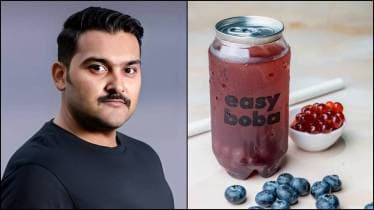Adnan Sarkar, the visionary founder behind Easy Boba, sheds light on his pioneering journey to introduce bubble tea to the Indian market. Inspired by his travels through Southeast Asia, where he witnessed the fervor surrounding bubble tea, Adnan recognized an untapped opportunity in Mumbai’s vibrant tea culture. Since its inception, Easy Boba has not only captured the essence of authentic bubble tea but has also navigated unique challenges in educating and satisfying the diverse Indian palate.
Q1. What inspired you to bring bubble tea to the Indian market, and how has the journey been so far?
Adnan Sarkar: My journey into the world of bubble tea started during my travels through Southeast Asia, where I experienced the bubble tea frenzy firsthand. I saw immense potential for this concept in Mumbai, especially given India’s vibrant tea culture. The journey so far has been both challenging and incredibly rewarding. I’m proud of how Easy Boba has been received in the Indian market and the way we’ve been able to innovate while staying true to the authentic flavors of bubble tea.
Q2. Bubble tea offers a wide range of flavors. What are the most popular flavors in India, and how do they differ from global trends?
Adnan Sarkar: In India, flavors like Matcha, Thai Tea, and Taro are trendy and align with global trends. However, Indian customers also appreciate traditional teas like Jasmine Tea. Unlike other markets, Indian consumers are more particular about the balance of sweetness and texture, which is why we put a lot of effort into perfecting our recipes to meet their preferences.
Q3. How has the Indian food and beverage market responded to this new concept of bubble tea? Were there any initial challenges in educating customers?
Adnan Sarkar: The response has been overwhelmingly positive. However, in the early stages, educating customers about bubble tea was a challenge. Many were unfamiliar with tapioca pearls or popping boba, and some had reservations about trying something so different. However, we focused on offering a welcoming environment and giving customers the freedom to explore a variety of flavors. Once they tasted it, the quality and uniqueness spoke for themselves.
Q4. What unique flavors or ingredients have you incorporated to cater to Indian tastes, and how important is local adaptation for your brand?
Adnan Sarkar: Although we source our ingredients directly from Taiwan to ensure authenticity, we remain attentive to the preferences of the local palate. Indian customers often favor sweeter, richer, and more familiar flavors, so we’ve thoughtfully adjusted our offerings to meet these tastes without losing the international essence of the drink. However, we’ve deliberately avoided fully Indianizing our menu, maintaining the integrity of the original bubble tea experience.
Q5. With hospitality being such an important part of food service, how does Easy Boba ensure a great customer experience across your locations?
Adnan Sarkar: Customer experience is paramount at Easy Boba. We ensure that every outlet provides a premium experience—from the taste of the beverage to the ambiance of the store. Our staff is trained to engage with customers and educate them about our product, and we take customer feedback very seriously. We’ve also integrated eco-friendly practices, like using recyclable sealed PET cans and biodegradable rice straws, which resonate with today’s conscious consumers.
Q6. What challenges have you faced in setting up and scaling a business in the bubble tea industry, particularly in India’s diverse market?
Adnan Sarkar: One of the key challenges we encountered was a lack of awareness about authentic bubble tea in India. This required considerable effort in educating customers and countering misinformation, particularly since many local vendors were offering substandard, Indianized versions of the product. Ensuring that we provide an authentic experience has been critical at the front end.
At the back end, creating a scalable product posed its own difficulties. We needed to streamline our production process to be less reliant on servers and staff. To address this, we modified our raw materials, simplifying our standard operating procedures (SOPs) so that most of the menu could be prepared with just one or two basic steps. This required sourcing large quantities of customized raw materials, which couldn’t be achieved on a small scale. However, securing high-quality, customized ingredients became an essential part of our success.
Another factor we considered while scaling was India’s diverse climates and local conditions. We chose not to use perishable ingredients like dairy products, instead opting for non-dairy creamers, which have an 18-month shelf life. This decision not only reduced wastage to nearly zero but also ensured that the taste of our products remained consistent across all Easy Boba outlets in India.
These challenges ultimately pushed us to innovate and refine our processes, allowing us to deliver a uniform and authentic bubble tea experience throughout the country.
Q7. What are your future plans for Easy Boba? Do you see bubble tea becoming a mainstream beverage in India like chai or coffee?
Adnan Sarkar: Absolutely! We’re committed to expanding Easy Boba across India and making bubble tea a mainstream beverage option. Over the past 14 months, we’ve grown to 9 outlets in Mumbai, and 1 at Rajkot; we have plans to open more stores across cities like Pune, Rajkot, and Surat. I believe bubble tea has the potential to become as ubiquitous as chai or coffee, especially among younger generations who are more open to experimenting with new flavors.
